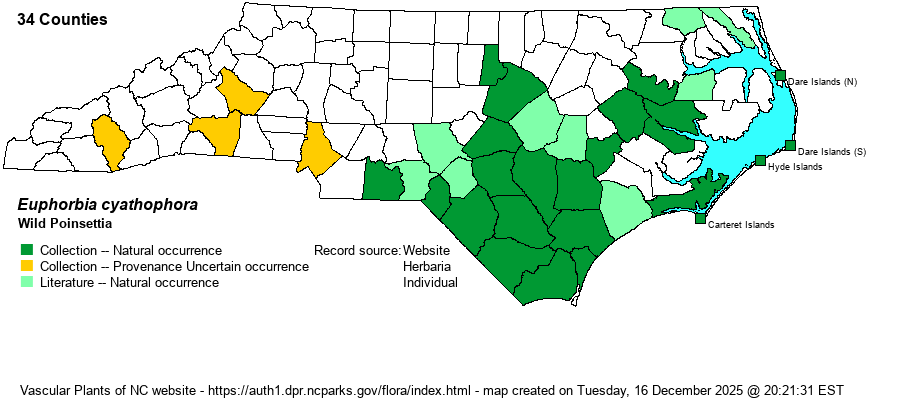| Author | Murray | |
| Distribution | Mostly Coastal Plain (including the Outer Banks), and Durham and Anson counties in the Piedmont. Scattered records westward in the Piedmont and low Mountains are thought to be adventive.
Weakley (2018) says that the original range is obscure, whereas FNA says it is native to midwestern and southeastern U.S., Mex., and C.A. Widely planted and escaped elsewhere. | |
| Abundance | Infrequent to uncommonly encountered, although local populations may contain many plants. Very rare to rare over much of the Coastal Plain, especially the northern portions. | |
| Habitat | Dry to mesic, disturbed soils, waste lots, roadsides, fallow fields, stable dunes, occasionally in bottomland forests. | |
| Phenology | Flowering and fruiting June-October. | |
| Identification | The species is virtually unmistakable with its flaming red (at least partially) leafy bracts at the inflorescence. Stems grow 1-3 feet tall, but usually less than 2 feet. Leaves are alternate or opposite, overall elliptic in outline but usually sinuate-lobed to resemble Overcup Oak (Quercus lyrata). The actual flowers, in clusters at branch ends, are small and greenish yellow, so it is the red to pink bracts that draw attention. This species generally grows in weedy places, or at least in somewhat cleared places, certainly seeming like an exotic species, though as mentioned above, its true native range is somewhat obscure, though certainly native to states to our west. | |
| Taxonomic Comments | The name E. heterophylla Linnaeus has been misapplied to our Wild Poinsettia.
| |
| Other Common Name(s) | Painted Leaf, Fire-on-the-mountain, Dwarf Poinsettia, Summer Poinsettia | |
| State Rank | SU [S3?] | |
| Global Rank | G5 | |
| State Status | | |
| US Status | | |
| USACE-agcp | FACU link |
| USACE-emp | UPL link |

